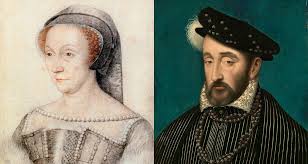History is full of intriguing tales of royal mistresses, and 16th-century France offers no exception. Diane de Poitiers was a woman with such influence over the reigning king that she even surpassed his legitimate queen in power. Join us as we explore the scandalous affair that changed the course of French history.
The Unconventional Love Story
In a surprising turn of events, Diane de Poitiers became the mistress of Henry II when she was 35 and he was just 15 years old. Their passionate affair lasted over two decades, with Diane remaining by Henry’s side as he rose from Duke of Orléans to King of France.
Henry’s love for Diane was clear, as he showered her with expensive gifts and gave her the Crown Jewels of France. He even granted her a grand château that his wife, Catherine de’ Medici, desired. Diane not only acted as the king’s confidante but also helped raise their children, advised on political matters, and co-signed letters with Henry using their combined names: “HenriDiane.”
A Heroine’s Fall from Grace
Tragedy struck when Henry died in a jousting accident in 1559. Without the king’s protection, Catherine de’ Medici revealed her true feelings toward Diane. Catherine quickly banished Diane from the royal court, ending her reign as the most powerful woman in France. Diane spent her final years in exile, far from the luxury she once enjoyed.
The Origins of a Scandalous Love
Diane de Poitiers, born in Drôme, France, charmed her way into history. Raised in a noble family, she received a comprehensive education in subjects like Latin, Greek, and rhetoric, preparing her for life in the aristocracy.
Diane and Henry’s connection began long before their love affair. As a courtier to King Francis I, Diane’s first husband, Louis de Brézé, introduced her to a world where she would become influential. During her time at court, she served prominent women, including Henry’s mother, Queen Claude.
A Journey to Influence
Diane’s rise to power wasn’t easy. King Francis I had his own lover, Anne de Pisseleu, who disliked Diane intensely. In 1544, Anne persuaded the king that Diane and Henry were plotting to bring back an exiled courtier. As a result, King Francis banished Diane from the court, and Henry, loyal to his beloved mistress, left with her.
However, Diane’s fortunes soon changed. After Francis’s death, Diane de Poitiers became one of the most influential women in France. This rise deeply embarrassed Catherine, especially during Henry’s coronation when Pope Paul III gave symbolic gifts to both Catherine and Diane, highlighting Diane’s powerful position.
The Limits of Power and the Legacy Left Behind
Henry II was willing to give Diane de Poitiers almost anything she wanted. She advised the king on many matters and often signed letters on his behalf, including her name alongside his. Henry also gave her prestigious titles like Duchess of Valentinois and Duchesse d’Étampes.
Despite her influence, Diane knew the importance of keeping Catherine happy. She often encouraged Henry to fulfill his marital duties, leading to the birth of ten children during their reign.
Yet, Henry’s infidelities weren’t limited to Diane. He had at least three illegitimate children with other women, including a daughter named Diane with Filippa Duci. However, Diane de Poitiers held a special place in Henry’s heart, symbolized by his public display of her ribbons during jousting tournaments, which hurt Catherine deeply.
This tension peaked when Henry died in a jousting accident in 1559. Consumed by jealousy, Catherine barred Diane from Henry’s final moments, ignoring his pleas to see her. Henry’s death abruptly ended Diane’s significant influence.
The Exiled Legacy
Once Catherine’s true feelings were revealed, she quickly reclaimed the Crown Jewels given to Diane. The grand château of Chenonceau, granted by Henry, was exchanged for the less desirable Château de Chaumont. Stripped of her former glory, Diane retired quietly to Château d’Anet, a manor she built during her time as Henry II’s mistress.
Despite the peace of her ancestral home, Diane’s life took a turn in 1565 when she was severely injured in a horse-riding accident. Suffering from fractured tibia and fibula, she faced a long and difficult recovery. Sadly, on April 25, 1566, at the age of 66, Diane de Poitiers passed away.
A study of her remains in 2008 revealed she had consumed a gold elixir during her life, hoping to preserve her youth. High levels of gold found in her hair confirmed the rumors about her use of the elixir, though the full impact on her health remains unknown.
Initially buried in an elaborate tomb near Anet, Diane’s remains were disturbed during the French Revolution. In 2008, her remains were rediscovered in a mass grave. After respectful examination, Diane de Poitiers was reburied in her original resting place.
A Timeless Legacy
Diane de Poitiers lived a life that fascinated many. From her privileged upbringing to her years as one of France’s most powerful women, Diane left a lasting impression on all who knew her and continues to influence French history to this day.
